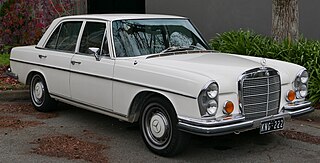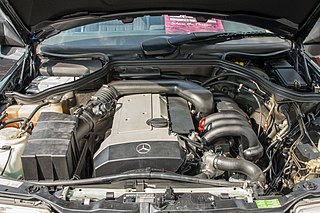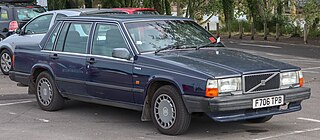
The Mercedes-Benz 124 series is a range of mid-size cars made by Daimler-Benz from 1984 to 1997. The internal chassis designation for saloon models is W 124, but Daimler-Benz also produced the 124 series in estate (S 124), coupé (C 124), cabriolet (A 124), limousine (V 124), rolling chassis (F 124), and long-wheelbase rolling chassis (VF 124) versions. From 1993, the 124 series was officially dubbed the Mercedes-Benz E-Class, and it was the first Mercedes-Benz type to be officially referred to as such. The W 124 started replacing the 123 series from 1984 and was succeeded by the W 210 E-Class after 1995, and the C 208 CLK-Class in 1997.
Mercedes-Benz has sold a number of automobiles with the "280" model name:

The M110 engine family is a DOHC crossflow cylinder head design with 2 valves per cylinder straight-6 automobile engine made by Mercedes-Benz in the 1970s and 1980s.

The OM617 engine family is a straight-5 diesel automobile engine from Mercedes-Benz used in the 1970s and 1980s. It is a direct development from the straight-4 OM616. It was sold in vehicles from 1974 to 1991. The OM617 is considered to be one of the most reliable engines ever produced with engines often reaching over 1,000,000 km (620,000 mi) without being rebuilt and is one of the key reasons for Mercedes' popularity in North America in the 1980s, as it was powerful and reliable compared to other automotive diesels of the time. It is also a very popular choice for the use of alternative fuels, mainly straight or waste vegetable oil and biodiesel, although the use of these fuels may cause engine damage over time if not processed properly before use.

The Mercedes-Benz W126 is the company's internal designation for its second generation S-Class, manufactured in sedan/saloon (1979–1991) and coupé (1981–1990) models, succeeding the company's W116 range. Mercedes introduced the 2-door C126 coupé model, marketed as the SEC, in September 1981. This generation was the first S-Class to have separate chassis codes for standard and long wheelbases and for coupé (C126).

The Mercedes-Benz W108 and W109 are luxury cars produced by Mercedes-Benz from 1965 through to 1972 and 1973 in North America only. The line was an update of the predecessor W111 and W112 fintail sedans. The cars were successful in West Germany and in export markets including North America and Southeast Asia. During the seven-year run, a total of 383,361 units were manufactured.

The Mercedes-Benz M104 is a straight-6 automobile engine produced from 1989 through 1999. It has a double overhead cam design with 4 valves per cylinder, and used a crossflow cylinder head. It replaced the M103 and was replaced by the M112 V6 starting in 1997. The M104 continued in production until 1999 where its last use by Mercedes-Benz was in the W140 chassis. The bore spacing on all M104 engines is the same as the M103 engine at 97 mm.

The Mercedes-Benz W116 is a series of flagship luxury sedans produced from September 1972 until 1980. The W116 automobiles were the first Mercedes-Benz models to be officially called S-Class, although earlier sedan models had already unofficially been designated with the letter 'S' – for Sonderklasse or "special class." The W116 was selected European Car of the Year in 1974.

The Mercedes-Benz W140 is a series of flagship vehicles manufactured by Mercedes-Benz from 1991 to 1998 in sedan/saloon and coupe body styles and two wheelbase lengths. Mercedes-Benz unveiled the W140 S-Class at Geneva Motor Show in March 1991 with sales launch in April 1991 and North American launch in August 1991.

The Volvo 700 series is a range of executive cars produced by the Swedish manufacturer Volvo Cars from 1982 to 1992. The 700 series was introduced in 1982 with the luxurious 760, followed two years later by the lower priced 740 which capitalized on the prestige attained by the very similar 760. The 700 series was then gradually replaced, beginning in 1990, by the 900 series. The 700, designed by Jan Wilsgaard, was originally to have been a replacement for the 200 series, but production of that model continued until the early nineties. The expensive 780, a Bertone-designed coupé version, entered production in 1986 and departed without a direct successor only four years later.
The 4HP 22 is a four-speed automatic transmission from ZF Friedrichshafen AG for passenger cars with rear wheel drive or 4X4 layout. Introduced in 1980, it was produced through 2003, and has been used in a variety of cars from BMW, General Motors, Jaguar, Land Rover, Maserati, Peugeot, Porsche, and Volvo.

María del Socorro Tellado López, known as Corín Tellado, was a prolific Spanish writer of romantic novels and photonovels that were best-sellers in several Spanish-language countries. She published more than 4,000 titles and sold more than 400 million books which have been translated into several languages. She was listed in the 1994 Guinness World Records as having sold the most books written in Spanish, and earlier in 1962 UNESCO declared her the most read Spanish writer after Miguel de Cervantes.

The Mercedes-Benz M117 is an OHC, 2 valve per cylinder V8 engine made in several versions by Mercedes-Benz between 1971 and 1992.

Hidden headlamps, also commonly known as pop-up headlamps, pop-up headlights, flip-eye headlamps, hideaway headlights, are a form of automotive lighting and an automotive styling feature that conceals an automobile's headlamps when they are not in use.
This is a list of automobiles produced for the general public in the European market. They are listed in chronological order from when each model began its model year. If a model did not have continuous production, it is listed again on the model year production resumed. Concept cars and submodels are not listed unless they are themselves notable.
This page is based on this
Wikipedia article Text is available under the
CC BY-SA 4.0 license; additional terms may apply.
Images, videos and audio are available under their respective licenses.











